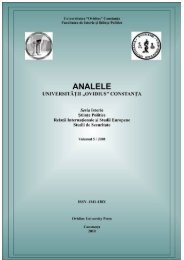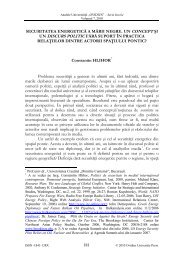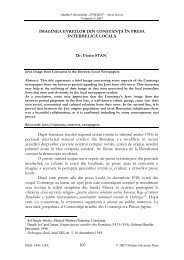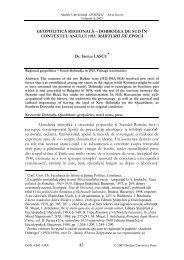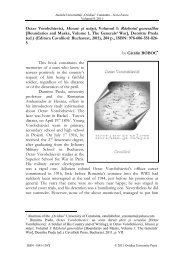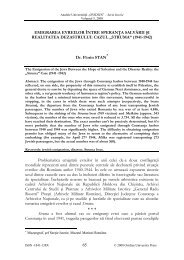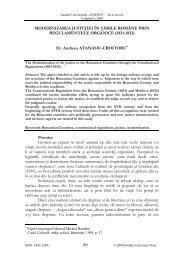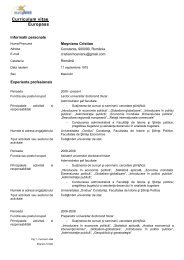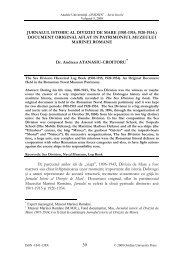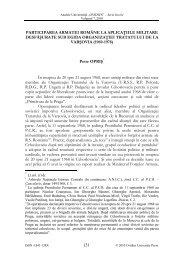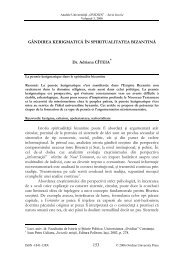analele universitÄÅ£ii âovidiusâ constanÅ£a - AUOCSI
analele universitÄÅ£ii âovidiusâ constanÅ£a - AUOCSI
analele universitÄÅ£ii âovidiusâ constanÅ£a - AUOCSI
Create successful ePaper yourself
Turn your PDF publications into a flip-book with our unique Google optimized e-Paper software.
Analele Universităţii „OVIDIUS” – Seria Istorie<br />
Volumul 6, 2009<br />
A FI SAU A NU FI “GENOCID” DRAMA FEMEILOR DIN<br />
DARFUR/SUDAN – PIESA UNUI GENOCID ASCUNS<br />
Alis-Mihaela BIRTU-PÎRĂIANU (BÂLCĂ) <br />
To Be or not to Be „Genocide” Darfur/Sudan Women’s Drama – a Piece of a Cover<br />
Genocide<br />
Abstract: Darfur is a significant proof that genocide is still part of our society and a<br />
serious problem for that matter. Compared to Rwanda, where 800.000 people were killed<br />
in one hundred days of civil war, ethnic cleansing in Darfur has been taking place for<br />
about seven years, since 2003. One of the most disturbing aspects of the Darfur alleged<br />
genocide is the everyday drama of women in this region. Here parties to the conflict<br />
continue to use rape as a weapon of war in conditions of impunity, as victims who<br />
denounce the situation are likely to be prosecuted and while the Government of Sudan<br />
has denied repeatedly and publicly that sexual violence does not exist in Darfur.<br />
The everyday women drama in Darfur / Sudan is nothing more than a part of a<br />
complex, denied and hidden genocide. Whether or not we accept the genocide term,<br />
Darfur remains a symbol of pain, but also an opportunity for solidarity and a tough test<br />
for the entire world.<br />
Keywords: genocide, Darfur, rape, violence, impunity.<br />
Faţă de Rwanda, unde 800.000 de oameni au fost ucişi în o sută de zile<br />
de război civil 1 , purificarea etnică din Darfur durează de aproximativ şapte ani,<br />
“iar cei care mai îndrăznesc să spună că «nu se va mai întâmpla niciodată» dau<br />
dovadă fie de inconştienţă, fie de o ipocrizie monstruoasă.” 2<br />
Darfur apare doar ca un coşmar, departe de percepţia şi imaginaţia<br />
societăţii de astăzi. Genocidul din Darfur apare ca o monstuozitate inacceptabilă<br />
şi ireală într-o lume evoluată.<br />
Genocidul în sine pare legat de o lume dispărută, de lăcomia coloniştilor<br />
americani, de o Germanie inumană sau de o Turcie virulentă. Când vorbim<br />
despre genocid, ne apare în faţa ochilor fără întârziere seria de monumente<br />
dedicate victimelor Holocaustului, inclusiv imaginea Holocaust-Mahnmal din<br />
Berlin. 3 Inaugurat după lungi dezbateri şi proteste în 2005, acesta reprezintă<br />
Studentă în cadrul Facultăţii de Istorie şi Ştiinţe Politice, Specializare Relaţii Intenaţionale<br />
şi Studii Europene, An III; text extras din lucrarea de licenţă “Conflictul din Darfur/Sudan –<br />
poveste fără de sfârşit”.<br />
1 BBC News, Rwanda: How the genocide happened, 18 decembrie 2008,<br />
http://news.bbc.co.uk/2/hi/1288230.stm, (accesat 19 martie 2010).<br />
2 Gérard Prunier, Darfur, cronica unui genocid negociat, “Le monde diplomatique”, ediţia<br />
română, anul III, nr. 31, martie 2007.<br />
3 Memorialul Holocaustului, BBC News, Berlin opens Holaucaust memorial, 10 mai 2005,<br />
http://news.bbc.co.uk/2/hi/4531669.stm, (accesat 6 aprilie 2010).<br />
ISSN -1841-138X 173 © 2009 Ovidius University Press



